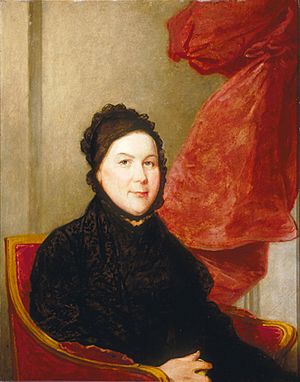Catharine Littlefield Greene facts for kids
Catharine Littlefield Greene (born February 17, 1755 – died September 2, 1814) was a smart and active American woman. She was the wife of Nathanael Greene, a famous general in the Continental Army during the American Revolutionary War. Catharine was a mother of five children. She is especially known for supporting the inventor Eli Whitney, who created the cotton gin. People described her as having a very active mind and being quick to understand new ideas.
Contents
Early Life and the Revolutionary War
Catharine Littlefield was born on February 17, 1755, on Block Island in Rhode Island. Her family had lived there since the 1660s and was quite wealthy. Her father, John Littlefield, was a member of the Rhode Island government.
When Catharine was 10, her mother passed away. She then went to live with her aunt and uncle. They were also involved in local government, which helped Catharine learn about how things worked. She received a good education and learned important skills for running a home.
In 1772, she met Nathanael Greene, who was a bit older than her. They got married in July 1774. However, less than a year later, Nathanael had to leave for the war. Catharine was used to her husband making decisions, but with him gone, she had to take charge of their home.
Life During the War
Catharine didn't want to stay home alone while her husband was fighting. So, she often joined General Greene at his military camps whenever she could. During the war and shortly after, Catharine had five children who grew up healthy.
Visiting her husband often helped her feel less worried. She also became friends with other people stationed with him. Her living conditions at camp were usually good. She often helped plan social events to give the soldiers a break. It was hard for her to care for her children while also wanting to be with her husband. She really wanted a normal family life. When possible, she brought her young children to camp. Other times, she left them with family or friends. These times apart made her feel how much the war affected her family.
When the war finally ended, Catharine was excited for Nathanael to come home. She looked forward to him helping raise their children and manage their home and business. His return brought her a peace of mind she hadn't felt since the war began. She was ready to let her husband lead and settle into the life of a respected wife.
Challenges After the War
During his time leading soldiers in the South, Nathanael faced very tough conditions. To get clothes for his soldiers in winter, he had to promise to pay thousands of dollars to merchants in Charleston, South Carolina. Later, he found out that the person he dealt with was dishonest.
After the war, the merchants demanded their money, and courts ordered Nathanael to pay. He didn't have enough money and was deeply in debt. Catharine found it hard to accept being poor. They had won the war, but they had little to show for it. Her dream of being wealthy and having free time was shattered. She couldn't even count on basic security anymore.
In 1785, Nathanael decided to move the family to a plantation called Mulberry Grove in Chatham County, Georgia. The state of Georgia had given him this land to thank him for his service. He hoped to grow rice there and sell other lands to pay off their debts. This move was especially difficult for Catharine, who had lived in the North her whole life. She had to leave many friends and what was left of her family.
Catharine soon realized how much these problems weighed on Nathanael. She saw a tired, worn-out former soldier who had given everything for his country. Catharine decided to do everything she could to help him. She worked hard to manage the plantation, determined to make Mulberry Grove a success. However, her plans were interrupted when Nathanael suddenly died on June 19, 1786, from sunstroke.
Life After Nathanael's Death
After Nathanael's death, Catharine faced the challenge of raising her children and dealing with her husband's huge debts. With help from the new plantation manager, Phineas Miller, who had been her children's teacher, Mulberry Grove began to do well by 1788.
A trusted friend encouraged her to ask the United States Congress for money to cover the debts Nathanael had paid to the Charleston merchants. On April 27, 1792, President George Washington approved a law that helped the Greene family pay off their debts. Catharine was very happy and wrote to a friend, saying she felt strong and independent. She was proud of her success, especially because some friends had doubted her.
Helping Invent the Cotton Gin
In that same year, Catharine met a young man named Eli Whitney. He was teaching her neighbor's children. With her encouragement, Eli Whitney came to live at Mulberry Grove to work on his inventions. Within a year, he had created a model for the cotton gin.
In 1883, an article in The North American Review claimed that Catharine Greene suggested to Whitney the idea of using a brush-like part. This part was very important for separating the seeds from the cotton. However, there is no clear proof to confirm Catharine Greene's exact role in inventing the cotton gin.
Second Marriage and Later Life
Catharine Greene married Phineas Miller on June 13, 1796, in Philadelphia. President George Washington and his wife, Martha Washington, were witnesses at their wedding.
Catharine Miller lived at the Dungeness plantation until she passed away in 1814. She was buried there.
Images for kids



